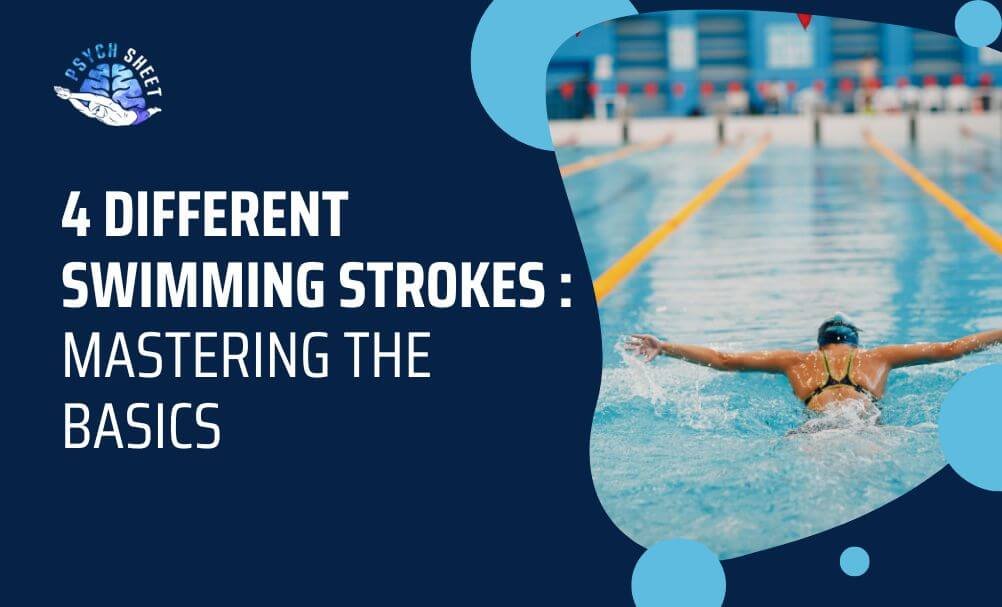4 Different Swimming Strokes: Mastering the Basics

Swimming is a fun and refreshing way to stay fit and healthy. It’s excellent for both your body and mind. Whether you’re just starting or have been swimming for a while and want to get better, knowing the different swimming strokes helps. In this guide, we’ll examine the four main swimming strokes: freestyle, backstroke, breaststroke, and butterfly.
Each of these strokes has its unique way of moving in the water and has different benefits. For example, freestyle is fast and suitable for long distances, while breaststroke is slower and great for relaxing. Backstroke lets you breathe easily since your face is out of the water, and the butterfly gives you an intense workout.
Learning these different swimming strokes can make your time in the pool more interesting and fun. You can switch between strokes to keep your workouts exciting and work on other parts of your body. Understanding these strokes makes swimming a versatile and enjoyable sport for everyone, whether for fun, fitness, or learning new skills.
Four Different Swimming Strokes Are As Follows:
1. Freestyle Stroke (Front Crawl)
Freestyle, also known as the front crawl, is one of the most popular different swimming strokes. It’s especially famous for being fast and efficient, which is why so many swimmers choose it for races.
When you swim freestyle, you lie on your stomach and cut through the water with your arms and legs. Your arms take turns pulling and pushing the water, moving in a windmill motion. While one arm stretches forward, the other one pushes water backward. This helps you move quickly through the water.
Your legs do a flutter kick, moving up and down fast. This adds to your speed and helps keep your body balanced in the water.
You also need to turn your head to the side to breathe without interrupting your arm strokes. This needs to be timed well so you can keep moving smoothly and quickly.
Freestyle is a fundamental part of different swimming strokes and is great for building endurance and strength because it uses many muscles in your body. It’s a good stroke to learn if you want to swim fast or if you just enjoy swimming for exercise.
Technique:
- Body Position: The body should be flat and horizontal, lying on the stomach. The body rolls slightly from side to side with each stroke.
- Arm Movement: Arms move alternately, with one arm pulling underwater from an extended forward position down to the hip, while the other recovers above water.
- Leg Movement: The legs perform a flutter kick, moving in a quick, compact, and continuous motion.
- Breathing: Breathing is done by turning the head to one side during the arm recovery phase, taking a breath every few strokes.
Benefits:
- Increases endurance and strength, particularly in the arms and shoulders.
- Improves cardiovascular health.
- Fastest method to cover long distances in water.
2. Backstroke
Backstroke is a special kind of swimming and stands out among the different swimming strokes because it’s the only one done on your back. This makes it a great choice for beginners because you don’t have to put your head under the water, which can make some people feel nervous.
When you swim backstroke, you float on your back and look up at the sky or ceiling. Your arms move in a windmill motion, one arm at a time, pulling water down toward your hips to propel you forward. This arm action is smooth and requires coordination to keep you moving straight.
Your legs perform a flutter kick, similar to the one used in freestyle, where your legs kick alternately to help move you along and keep your body stable and flat on the water.
One of the best things about backstroke is that it allows you to breathe easily. Since your face is always above water, you can breathe whenever you want without worrying about timing your breaths with your strokes. This can make swimming more relaxing and enjoyable.
Overall, backstroke is a fundamental part of different swimming strokes, and it’s particularly good for strengthening the muscles in your back, improving posture, and enhancing coordination and flexibility.
Technique:
- Body Position: Lie flat on your back with your body straight and your eyes looking upwards.
- Arm Movement: Arms move alternately in a windmill motion, entering the water straight above the shoulder and pushing down toward the hips.
- Leg Movement: Similar to freestyle, the flutter kick is used, with legs kicking alternately to provide propulsion.
- Breathing: Breathing is easier in backstroke since the face remains out of the water.
Benefits:
- Improves posture and flexibility in the back.
- Strengthens the stomach and core muscles.
- Relatively relaxing, as it allows for easy breathing.
3. Breaststroke
Breaststroke is one of the oldest and most unique different swimming strokes. It is famous for its distinctive, frog-like kick. This stroke is great for exercising the thighs and chest because of the way you move in the water.
When you do the breaststroke, you start with your body flat and face down in the water. You pull your arms through the water in a half-circle motion at chest level. Your legs perform a frog kick: you bend your knees and feet outward and then push them together to propel yourself forward. This stroke looks much like a frog swimming in the water.
Breaststroke allows you to keep your head above the water most of the time, making it easier to breathe compared to other strokes. This can make swimming more relaxing and enjoyable.
Overall, breaststroke is a gentle yet effective way to strengthen your muscles and improve flexibility. It’s part of the different swimming strokes that offers a balanced workout and is especially good for those who enjoy a slower, more measured pace in the water.
Technique:
- Body Position: Start with the body flat and face down in the water.
- Arm Movement: Arms move simultaneously, sweeping outwards and then together in front of the chest in a circular motion.
- Leg Movement: The legs perform a frog kick—bending at the knees and then sweeping the legs outward and backward.
- Breathing: Lift your head to breathe in as your arms pull, then exhale as your arms extend forward.
Benefits:
- Enhances flexibility in the hips and inner thighs.
- Good for building strength in the upper body and legs.
- Considered one of the more relaxing strokes that can be sustained over long periods.
4. Butterfly Stroke
The butterfly stroke is known as the most challenging of the different swimming strokes due to its unique and powerful technique. This stroke requires a lot of strength and coordination, making it physically demanding.
When swimming the butterfly stroke, both arms move together in a circular motion, pulling and pushing the water simultaneously. Your legs perform a dolphin kick, where they stay together and kick in a whipping motion, similar to how a dolphin moves its tail. This combination of arm and leg movements creates a wave-like motion in the water, which is both beautiful and effective for fast swimming.
The butterfly stroke works out your entire body, particularly the shoulders, back, chest, and core muscles. Although it is tough, mastering this stroke can significantly increase your swimming speed and power.
Due to its intensity, the butterfly stroke is a great choice for building strength and improving overall fitness. It is a critical part of different swimming strokes and is often admired for the grace and athleticism it requires to be performed correctly.
Technique:
- Body Position: Keep the body flat and prone on the surface of the water.
- Arm Movement: Both arms move symmetrically, pulling the water from in front to past the hips.
- Leg Movement: The dolphin kick involves both legs moving together in an undulating motion, similar to a dolphin’s tail.
- Breathing: The swimmer breathes to the front by lifting the head out of the water at the end of the arm pull.
Benefits:
- Provides a high-intensity full-body workout, especially strengthening the core.
- Increases upper body strength.
- Improves timing and coordination.
Conclusion
Understanding and practicing the different swimming strokes can significantly enhance your swimming skills, fitness, and enjoyment of the sport. Each of the different swimming strokes—freestyle, backstroke, breaststroke, and butterfly—has its own techniques, benefits, and challenges. This diversity makes swimming a flexible and inclusive activity that is suitable for everyone.
Whether your goal is to compete, stay fit, or simply enjoy leisure time in the water, mastering these strokes will boost your confidence and make you more proficient. You’ll be able to handle various swimming situations and get the most out of your time in the pool.
If you want to improve your swimming or learn more about the benefits and techniques of different swimming strokes, please get in touch with Psychsheet for more information. They can provide you with resources and guidance to help enhance your swimming experience. If you’ve any questions or any doubts, do get in touch with us or book an appointment.
